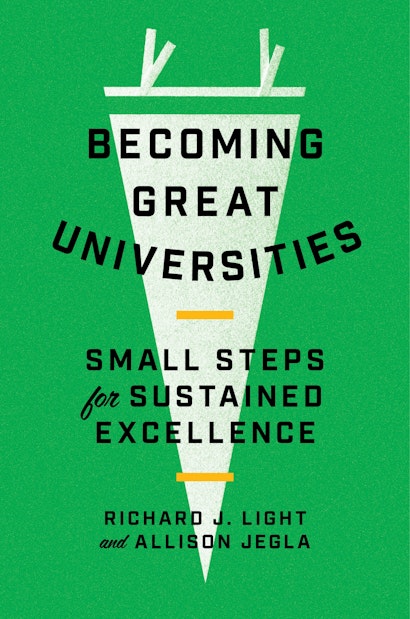Becoming Great Universities highlights ten core challenges that all colleges and universities face and offers practical steps that everyone on campus—from presidents to first-year undergraduates—can take to enhance student life and learning. Richard Light and Allison Jegla cover topics such as how to build a culture of innovation on campus, how to improve learning outcomes through experimentation, how to help students from under-resourced high schools succeed in college, and how to attract students from rural areas who may not be considering colleges far from their communities.
How did the two of you come together to write this book?
We’re a bit of an unlikely pair! From first glance, we couldn’t be more different. Dick, a grandfather and longtime Harvard professor, grew up in hardscrabble Bronx, New York and attended an unchallenging high school. Allison, a recent graduate student, went to a small high school in rural mid-Michigan. When we arrived at the University of Pennsylvania for college, albeit separated by roughly fifty years, we each struggled. Both of us ultimately figured it out, thanks in part to Penn’s strong commitment to its students’ success. That bit of shared history, even though our experiences were so many years apart, gave the two of us plenty to talk about when we were fortuitously paired as academic advisor/graduate student advisee at Harvard. In our many conversations, particularly about the powerful impact that a great university can have on many aspects of students’ lives, we realized that we had a unique perspective to share. This book really was inspired by our shared love for and optimism about higher education.
Dozens of books are written every year about higher education. What makes yours different?
There are several key things that we can highlight. First, our book is intentionally conversational and focuses more on real-world examples than complex theoretical frameworks. We offer many actionable examples that we hope leave readers feeling energized to implement the ideas we highlight, or to consider acting upon their own.
Second, Dick has visited more than 250 college campuses globally during his career. He speaks with students and advises administrators at each, delving deep into both their specific challenges and triumphs. This has led to his ongoing work to synthesize strengths, pain points, and opportunities for improvement across institution type, size, student body composition, wealth, and geography—all of which has been infused into the book.
We also take a focused approach when discussing the importance of building a culture that encourages sustained campus improvement. One of our early arguments is that that there are hundreds of good, even very good, universities across America and the world. Yet a far smaller number are truly “exceptional” in some way. Nearly every one of those that are “exceptional” focuses on building a culture of innovation and improvement into campus life. Our friendly challenge to readers is that everyone on campus, from a first-year student to faculty to staff and many among the university leadership, has a key role to play for enhancing the undergraduate experience. We give many concrete, achievable, evidence-backed suggestions for getting started. The words “evidence-based” are a driving theme for this book.
Finally, we are proud that our book has a strong undercurrent of positivity and optimism. We believe that there is much to be excited about in the world of higher education. We hope that our book feels like a breath of fresh air in what is today an often-criticized field.
Does your book focus entirely on the academic side of a student’s experience at a college or university, or does it also explore the non-academic piece?
This is a great question, because the challenge of how to enrich students’ time out of the classroom probably constitutes more than half of our book. In Jim Collins’ management work, Good to Great, he and his research team examine a number of American corporations to understand why some are considered to be exceptional. Meanwhile others never made it past a stage that could be characterized as merely “pretty good.” We ask what that same concept—assessing the qualities that lead to earned distinction—would look like when applied to “the student experience” at America’s many colleges and universities.
After exploring our own experiences, including Light’s research findings about the topic of higher education excellence, and Jegla’s work for ten years helping young women from the Midwest to widen the scope of their college search, we offer one answer that we hope many campuses will consider. It is the transcendent importance of the idea of cultivating personal relationships. Those relationships might be focused among students’ engagement, friendships, and collaboration with one another. Or they might focus on engagement between faculty and students. In yet other cases, it might be a team of research colleagues working with a group of student advisees. Whatever the details, a key point in our book is that each student should feel that someone on their campus knows them and cares that they are there.
It is no secret that Harvard is, by any reasonable standard, incredibly well resourced. Professor Light, you are a longtime senior professor there. Ms. Jegla, you recently earned your graduate degree there. Do your suggestions in this book require substantial financial support? What do you say to the leaders of universities who might think, “Our institution is nothing like Harvard—we don’t have its resources—so we are limited in what changes we can make”?
Your specific question was on both of our minds as we designed and wrote our book. We offer overall more than a hundred concrete examples of steps any campus can take to enhance their students’ experience and overall learning. Each example is actionable. Not a single one of those more than a hundred costs a significant amount of money. Actually, the vast majority cost exactly zero. A few do require some minimal level of faculty or staff time and effort, such as a staff or faculty member running a 90-minute workshop for students. Several others have truly small expenses (for example, photocopy expenses for creating handouts to distribute to students, or posters for publicity for workshops). We are proud that not a single idea we offer is expensive.
Could you share a concrete example of such an idea that costs very little and could be implemented across campus types, regardless of resources?
Sure. One of our favorites has to do with the role that undergraduates can play in enhancing the experience of many of their fellow students. A few years ago, a group of students were lamenting the fact that on their campus with many hundreds of superb professors, they were only able to hear from and learn from roughly 32 during their four years. These students decided to do something about that. They initiated a meeting with a Dean and proposed creating a public event on campus called “Ten Big ideas, Ten Professors, Ten Minutes Each.” The Dean welcomed their idea and their offer to do some work to contribute. She quickly set aside an evening to use the college’s largest auditorium.
Students chose and invited ten professors to each present their one “most exciting’’ new idea in less than ten minutes. Each faculty member whom the students invited enthusiastically agreed to volunteer their time. The event was a resounding success, with lines that snaked around the building and thunderous applause after each presentation. Students ended up hearing about fields they may never have explored or even known existed. Most also gained a deeper appreciation for the vibrancy and diversity of thought at their campus.
How much did this initiative cost? Zero. No college needs to be wealthy to do this. Hundreds of students benefit. The campus is enriched with new ideas and activities. New traditions are created. This is what can happen when students come up with an idea for their college and then actually implement it. Our book urges more students to begin to think along these lines. It is chock full of examples across topic areas. We urge campus leaders to encourage students to come up with new and creative ideas. Both of us bet that many students will be surprised at how supportive most campus leaders will be, to receive productive ideas from students about new campus programs that can enrich university life for everyone. Especially when those students are even volunteering to put in their own effort to make it happen.
University leadership may sometimes underestimate this point: how students can come up with good, new ideas that simply had not occurred to Deans or to others. This example illustrates our core theme that engaging everyone on campus to contribute what they can to enriching the undergraduate experience, helps to build a thriving and vibrant campus. If readers from a diverse group of universities find some of our actionable recommendations helpful and worth actually trying, we will consider our book a great success.
Richard J. Light is the Carl H. Pforzheimer Professor of Teaching and Learning at Harvard University. His books include Making the Most of College: Students Speak Their Minds and Summing Up: The Science of Reviewing Research. He lives in Belmont, Massachusetts. Allison Jegla is a nonprofit leader and higher education strategist. She is from Portland, Michigan.

